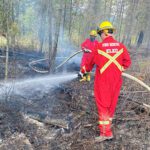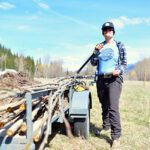Home »

Fighting the bite
Local mosquito control technicians working hard to reduce mosquitoes
It’s mosquito season again! Within the East Kootenay, mosquito eggs laid in previous years along the banks and seepage sites of the Kootenay River and various lakes are beginning to hatch.
Floodwater mosquitoes are triggered to hatch in the presence of water, typically from the freshet, when the weather starts warming up and snow melt increases the Kootenay River levels.
Snowmelt mosquitoes can also be a nuisance. Their eggs are triggered to hatch just when the snow begins to melt in landscape depressions in the early spring.
Your local mosquito control contractors are here to help. Morrow BioScience Ltd. (MBL) provides mosquito control services for three member communities within RDEK: Wasa, Ta Ta Creek, and Skookumchuck and also for the City of Cranbrook.
MBL has been conducting mosquito control within B.C. for nearly four decades and for over 20 years within the East Kootenay.
Residents may notice mosquito control contractors in brightly coloured vests sampling the flood and seepage waters for mosquito larvae, the life stage targeted during mosquito control operations.
Once the mosquito eggs have hatched and the larvae have started to develop, mosquito control contractors apply a bacterial larvicide to the seepage water to kill the larvae. The larvicide is made up of bacterial spores that target mosquitoes. When the mosquito eats the bacteria, it dies quickly.
Mosquito development sites within the region will be monitored once or twice weekly through early August.
Mosquito control contractors have already been out applying the bacterial larvicide throughout Cranbrook and will begin applying the bacterial larvicide by ground in early June within the Wasa, Ta Ta Creek, and Skookumchuck areas.
Helicopter treatments may also occur along the Kootenay River foreshore, depending on the local peak of the Kootenay River.
Aerial and ground treatments may continue through the summer, as dictated by environmental conditions necessary for floodwater mosquito development. The larvicide is not toxic to people, wildlife, or pets.
We are doing our very best to reduce floodwater mosquitoes so that they remain at tolerable levels and allow residents to be able to enjoy outdoor activities. Residents can help by reducing mosquito breeding sites around their properties, by removing or refreshing standing water daily.
These areas include bird baths, stored tires, clogged gutters, animal troughs, and kiddie pools, to name a few. We also encourage residents to reduce their exposure to mosquito bites through personal protective measures such as wearing long-sleeved shirts and pants, choosing light-coloured clothing, using insect repellent, deploying mosquito netting at home, and ensuring window screens are properly installed and maintained.
To report standing water or adult mosquito nuisance, residents of Cranbrook, Wasa, Ta Ta Creek, and Skookumchuck can call MBL’s Mosquito Hotline: 1-877-986-3363. Or email: [email protected]
Frequently Asked Questions
Question 1: What type of mosquitoes are controlled by Morrow BioScience Ltd (MBL)?
Most mosquito control programs operated by MBL, including the Regional District of East Kootenay program, focus on mosquitoes that develop in floodwaters, primarily during the spring freshet. Certain programs, such as the City of Cranbrook, also have snowmelt mosquito species.
Both have the same general lifecycle, with the larval phase targeted for control in each type of mosquitoes.
Question 2: What is the lifecycle of floodwater mosquito species within the program area?
Floodwater mosquito eggs are laid in the damp substrate along floodwater corridors. Flooding along with other environmental triggers allow for the eggs to hatch into larvae. Snowmelt
mosquito eggs are laid in depressions in the landscape that accumulate rain and snow. Warming temperatures in the early spring trigger snowmelt mosquito eggs to hatch.
The larvae go through four aquatic instar stages, which are also the primary feeding stages, prior to developing into pupae. Pupae then emerge into adults. The development process can take as little as four days in some species and conditions to as long as two weeks. Development times also depend on ambient and aquatic temperature; warmer water resulting in accelerated mosquito development.
Question 3: What does MBL do to control mosquitoes?
MBL applies a larval control product to mosquito development areas. The active ingredient is a soil-borne bacterium, Bacillus thuringiensis var. israelensis (Bti). When the mosquito larvae eat the bacterium, they’re killed quickly.
Question 4: Is the larval control product toxic?
As a naturally occurring bacterium, the larval control product is considered practically non-toxic to fish, amphibians, reptiles, mammals, and most insects.
Question 5: What diseases can mosquitoes transmit in Canada?
In Canada, mosquitoes have been shown to transmit West Nile virus, Eastern Equine encephalitis virus, and California serogroup viruses. West Nile virus is the most widely distributed vector borne disease in North America. As the climate in Canada becomes warmer, the environment is more hospitable to additional vectors and associated viruses.
Question 6: Can mosquitoes act as a vector for COVID-19?
At this time, there is no evidence that mosquitoes are involved in the spread of COVID-19 (SARS-CoV-2). It is thought that the COVID-19 virus may not survive the internal processes of the mosquito. Other supportive evidence for the inability of mosquitoes to act as vectors COVID-19 is that other Coronaviruses have not proven transmissible through mosquitoes.
Question 7: Is West Nile virus a concern in B.C.? What are the most recent levels?
West Nile virus (WNv) is only a slight concern in B.C. given the relatively few number of mosquito pools, birds, horses, and humans who have tested positive. The most recent BCCDC surveillance data are updated through December 2021. While no animals tested positive for WNv in 2021, two travel-related human cases were reported in B.C. in 2021. Certain container mosquitoes are WNv vectors. In warmer seasons, more container mosquito breeding occurs, leading to greater potential for WNv transmission.
Question 8: What can resident do to help reduce mosquitoes around their property or in their communities?
- remove or refresh standing water daily in the warmer months;
- ensure that outdoor plants or containers have a drainage hole;
- clear rain gutters of debris and make sure they drain;
- turn over wading pools when not in use;
- install screens on windows and doors; and
- report standing water to your local mosquito control technicians.
Question 9: How can residents get more information or contact MBL?
Website: morrowbioscience.com
MBL Mosquito Hotline: 1-877-986-3363
Email: [email protected]
Submitted by Morrow BioScience Ltd.







